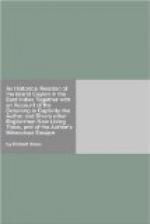[Jombo.] Another Fruit there is which I never saw in any other Parts of India, they call it Jombo. In tast it is like to an Apple, full of Juice, and pleasant to the Palate, and not unwholsom to the Body, and to the Eye no Fruit more amiable, being white, and delicately coloured with red, as if it were painted.
[Other fruits found in the Woods.] Also in the wild Woods are several sorts of pretty Fruits, as Murros, round in shape, and as big as a Cherry, and sweet to the tast; Dongs, nearest like to a black Cherry. Ambelo’s like to Barberries. Carolla cabella, Cabela pooke, and Polla’s, these are like to little Plums, and very well tasted. Paragidde, like to our Pears, and many more such like Fruits.
[Fruits common with other parts of India.] Here are also, of Indian Fruits, Coker-nuts; Plantins also and Banana’s of divers and sundry sorts, which are distinguished by the tast as well as by the names; rare sweet Oranges and sower ones, Limes but no Lemons, such as ours are; Pautaurings, in tast all one with a Lemon, but much bigger than a mans two fists, right Citrons, and a small sort of sweet Oranges. Here are several other sorts of Lemons, and Oranges, Mangoes of several sorts, and some very good and sweet to eat. In this sort of Fruit the King much delights, and hath them brought to him from all Parts of the Island. Pine-Apples also grow there, Sugar Canes, Water-Melons, Pomegranates, Grapes both black and white, Mirablins, Codjeu’s, and several other.
There are three other Trees that must not here be omitted; Which tho they bear no eatable Fruit, yet the Leaves of the one, and the Juice of the other, and the Bark of the third are very renowned, and of great benefit.
[The Tallipot; the rare Uses of the Leaf.] The first is the Tallipot; It is as big and tall as a Ships Mast, and very streight, bearing only Leaves: which are of great use and benefit to this People; one single Leaf being so broad and large, that it will cover some fifteen or twenty men, and keep them dry when it rains. The leaf being dryed is very strong, and limber and most wonderfully made for mens Convenience




